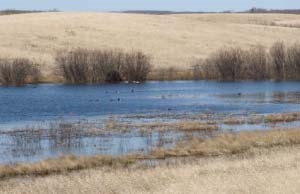Winter is a good time to reflect on your pasture planning and pasture monitoring strategy. One of the more recently develop assessment tools is called the Grazing Response Index or GRI for short. The index originated in the western US and British Columbia. Over the past four years, Agriculture and Agri-Food Canada (AAFC) has been actively involved in testing the validity of the GRI for the Prairie Provinces. Their preliminary findings indicate that the index can be a valuable tool in pasture assessments. The grazing response index is an attractive assessment tool for producers who are looking for a simple and relatively quick way of making management decision based on their current season grazing management.
A GRI assessment uses three components including: Frequency, Intensity, and Opportunity. Frequency looks at how many times grazing animals had an opportunity to graze plants. Opportunity for animals to re-graze the same plant is based on estimated plant growth rates. Where animals remain in the same pasture, opportunity for grazing is considered to occur every 7-10 days. For example, if a paddock is used for 30 days, there would be three 7-10 day periods within those 30 days. Intensity looks at how much leaf material has been removed during the grazing period. Intensity falls in one of three categories, including light, moderate, and heavy utilization. Heavy utilization is considered when more than 56% of the plant material has been removed. Opportunity refers to how much time the plants have to regrow between grazing events. Assessing opportunity can be somewhat subjective as recovery periods will also depend on whether conditions were favorable for plant growth. The categories in the opportunity rating range from “no chance to recover” to “full season” to recover.
The overall GRI rating will be the sum of the frequency, intensity, and opportunity index values ranging from +4 to -4. A positive overall value indicates that the current grazing management is beneficial for plant health. While a negative overall number indicates detrimental long-term effects of the current grazing management. A zero rating is neutral. Although a GRI assessment is a quick and relatively easy tool to use, it should still be combined with an on the ground range health assessment. Range health assessments should be completed in five to seven year intervals while GRI values can be calculated annually.
Producers will have to decide for themselves which assessment tools work best. Monitoring is key, because if something is not measured, it cannot be managed. Also keep in mind that a tool is only a means to the end goal of maintaining or improving pasture condition.
Nadia Mori PAg, Regional Forage Specialist, Watrous
Saskatchewan Ministry of Agriculture
For more information, please contact:
• Your regional Forage Specialist
• Agriculture Knowledge Centre (1-866-457-2377) or
• Visit our website at www.agriculture.gov.sk.ca

